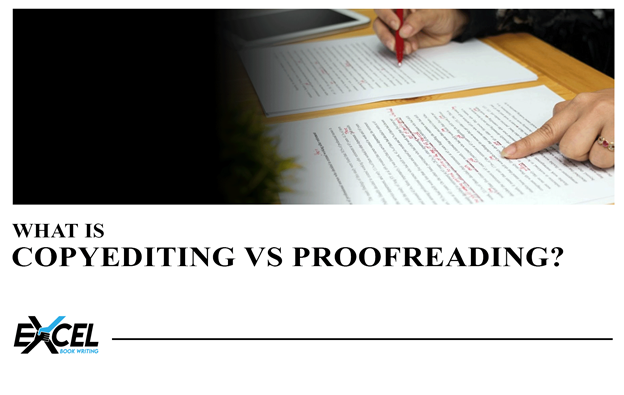What is Copyediting vs Proofreading?

Editing is an essential part of the book writing
process, ensuring that your manuscript is polished and ready for publication. However, there
are different types of book editing services, each serving a distinct purpose. Two of the
most commonly confused stages are copyediting and proofreading. Understanding the
differences between these two processes is crucial for authors who want to produce
high-quality work. In this blog, we will delve into the definitions, focus areas, roles,
examples, and tools and techniques associated with both copyediting and proofreading.
Understanding Copyediting
Copyediting is the process of reviewing and correcting a manuscript to improve its
readability, coherence, and overall quality. This stage involves a thorough examination of
the text to ensure it adheres to standard writing conventions and the author's intended
style.
Focus Areas
Copyeditors focus on several key areas to enhance the manuscript:
- Grammar: Correcting grammatical errors to ensure the text is
grammatically sound.
- Punctuation: Fixing punctuation mistakes to improve the flow and
clarity of sentences.
- Spelling: Identifying and correcting spelling errors.
- Syntax: Refining sentence structure for better readability and
coherence.
- Consistency: Ensuring consistency in style, tone, terminology, and
formatting throughout the manuscript.
Role of a Copyeditor
The role of a copyeditor is multifaceted. They are responsible for:
- Improving Clarity: Ensuring that the text is clear and easily
understandable.
- Enhancing Coherence: Making sure that ideas flow logically and
smoothly.
- Maintaining Readability: Ensuring the text is engaging and accessible
to the target audience.
Common copyediting tasks include:
- Correcting sentence structure to improve readability.
- Ensuring consistent tense usage throughout the manuscript.
- Rephrasing awkward or unclear sentences.
- Correcting misplaced modifiers and ensuring subject-verb agreement.
Copyeditors often use various tools and techniques to aid their work, such as:
- Style Guides: Reference guides like the Chicago Manual of Style to
ensure adherence to standard writing conventions.
- Track Changes: Using word processing software to track changes and
comments for the author's review.
- Consistency Checkers: Tools that help maintain consistency in
terminology and formatting.
Understanding Proofreading
Proofreading is the final review of a manuscript before it goes to print. This process
involves catching any remaining errors that may have been missed during previous book editing services stages.
Proofreading ensures that the manuscript is polished and error-free.
Focus Areas
Proofreaders focus on the finer details of the text, such as:
- Typos: Catching typographical errors that may have slipped through
earlier edits.
- Minor Errors: Correcting minor grammatical, punctuation, and spelling
mistakes.
- Formatting Issues: Ensuring consistent formatting, such as margins,
font styles, and headings.
Role of a Proofreader
The primary role of a proofreader is to perform a meticulous final check of the manuscript.
Their responsibilities include:
- Final Review: Conducting a thorough review to catch any remaining
errors.
- Ensuring Consistency: Ensuring that formatting and style are consistent
throughout the manuscript.
- Polishing: Making the manuscript ready for publication by eliminating
any errors.
Common proofreading tasks include:
- Fixing typographical errors.
- Ensuring consistent formatting for headings, subheadings, and body text.
- Correcting minor punctuation errors.
- Checking for consistent use of capital letters and numerals.
Proofreaders use a variety of tools and techniques to ensure accuracy, such as:
- Proofreading Marks: Traditional symbols used to indicate corrections on
printed manuscripts.
- Proofreading Software: Digital tools that help identify errors and
suggest corrections.
- Read-Aloud Technique: Reading the text aloud to catch errors that might
be missed when reading silently.
In the realm of book writing, both copyediting and proofreading play critical roles in
producing a polished and professional manuscript. Copyediting focuses on improving
readability, coherence, and consistency, while proofreading serves as the final check to
catch any remaining errors. Understanding the differences between these two processes can
help authors navigate the book editing services stages more effectively, ensuring their work
is of the highest quality. In the following sections, we will explore the key differences
between copyediting and proofreading, their importance in the book writing process, and tips
for working with professionals in these fields. Stay tuned to learn more about how to refine
your manuscript and bring your book to life.
Key Differences Between Copyediting and Proofreading
Understanding the distinctions between copyediting and proofreading is crucial for any
author. While both are essential stages in the book editing services process, they serve
different purposes and require unique skills.
Stage in the Editing Process
- Copyediting: Copyediting occurs after the initial draft of the
manuscript is completed but before the final proofreading stage. It is one of the first
comprehensive reviews of the text, focusing on refining the content for clarity,
coherence, and readability.
- Proofreading: Proofreading is the last step in the book editing
services process. It takes place after the manuscript has undergone copyediting and any
other necessary revisions. Proofreading ensures that the text is polished and ready for
publication, catching any remaining errors.
Depth of Review
- Copyediting: Involves a deep and thorough review of the manuscript.
Copyeditors look at the text in detail, scrutinizing every sentence for grammatical
accuracy, stylistic consistency, and overall flow. They may suggest rewrites or
rephrasing to enhance the text.
- Proofreading: Is a more surface-level review compared to copyediting.
Proofreaders focus on catching minor errors such as typos, spelling mistakes, and
formatting inconsistencies that were missed during the copyediting stage.
Focus Areas
- Copyediting: Focuses on grammar, punctuation, spelling, syntax,
consistency, clarity, coherence, and readability. Copyeditors ensure that the manuscript
adheres to style guides and maintains a consistent tone and voice.
- Proofreading: Concentrates on minor errors, including typographical
errors, minor grammatical mistakes, punctuation, and formatting issues. Proofreaders
ensure that the text is error-free and visually consistent.
Skills and Expertise
- Copyediting: Requires a deep understanding of grammar, syntax, and
style. Copyeditors need to have a keen eye for detail, strong language skills, and the
ability to enhance the author's voice while maintaining clarity and coherence.
- Proofreading: Demands meticulous attention to detail and a strong
command of language to catch minor errors. Proofreaders must be highly focused and
patient, as their role involves a careful, line-by-line review of the text.
The Importance of Both Processes in Book Writing
Both copyediting and proofreading are integral to the book writing process, each contributing
uniquely to the quality and success of the final manuscript.
Quality Assurance
- Copyediting: Ensures that the manuscript is clear, coherent, and
readable. By addressing grammatical errors, stylistic inconsistencies, and structural
issues, copyediting enhances the overall quality of the book. It transforms a rough
draft into a polished piece of writing that is engaging and easy to read.
- Proofreading: Serves as the final quality check, catching any remaining
errors that may have been overlooked during copyediting. Proofreading ensures that the
text is error-free and ready for publication, contributing to the professional
appearance of the book.
Author’s Intent
- Copyediting: Helps maintain the author's voice and intent while
improving readability. Copyeditors work closely with the text to ensure that the
author's message is conveyed clearly and effectively. They make suggestions that enhance
the narrative without altering the author's unique style.
- Proofreading: Ensures that the author's intent is preserved in the
final version of the manuscript. By catching minor errors and inconsistencies,
proofreaders help maintain the integrity of the author's work, ensuring that the final
product accurately represents their vision.
Error-Free Publication
- Proofreading: Plays a crucial role in ensuring that the manuscript is
free from errors and ready for publication. A well-proofread book is more likely to be
taken seriously by readers and critics, enhancing its chances of success in the market.
In the book writing process, both copyediting and proofreading are essential stages that
contribute to the overall quality and success of the final manuscript. While copyediting
focuses on improving clarity, coherence, and readability, proofreading ensures that the text
is error-free and polished for publication. Understanding the differences between these two
processes and the unique skills required for each can help authors produce high-quality,
professional books that resonate with readers. By investing in both copyediting and
proofreading, authors can ensure that their work is well-received and stands out in a
competitive market.
Choosing the Right Professional for Your Book
Selecting the right professionals for copyediting and proofreading is crucial to the success
of your manuscript. Here are some tips to help you find the best copyeditor and proofreader
for your book.
Finding a Copyeditor
A skilled copyeditor can significantly enhance the quality of your manuscript. Here’s how to
choose the right one:
- Seek Recommendations: Ask for recommendations from fellow authors,
writing groups, or online forums. Personal referrals can provide valuable insights into
the editor’s reliability and quality of work.
- Conduct a Trial Edit: Some copyeditors offer a trial edit of a few
pages. This can help you determine if their style matches your needs and if they can
enhance your manuscript effectively.
- Check Reviews and Testimonials: Look for reviews and testimonials from
previous clients to understand their experience and satisfaction with the copyeditor’s
work.
Finding a Proofreader
A meticulous proofreader ensures your manuscript is polished and error-free. Here’s how to
find a qualified proofreader:
- Attention to Detail: A good proofreader must have an exceptional eye
for detail. Look for someone who can spot even the smallest errors and inconsistencies.
- Experience: Choose a proofreader with experience in your genre or type
of writing. Familiarity with the specific conventions and expectations of your genre can
be a significant advantage.
- Seek Recommendations: Similar to finding a copyeditor, ask for
recommendations from fellow authors, writing groups, or online forums.
- Check Reviews and Testimonials: Look for feedback from previous clients
to gauge their satisfaction with the proofreader’s attention to detail and accuracy.
Working with Both
For the best results, consider working with both a copyeditor and a proofreader. Here’s why:
- Comprehensive Editing: A copyeditor will help refine your manuscript
for clarity, coherence, and readability, while a proofreader will catch any remaining
errors and ensure the text is polished.
- Different Skill Sets: Copyeditors and proofreaders possess different
skills and focus areas. Combining their expertise ensures that both the content and the
final presentation of your manuscript are of the highest quality.
- Double Layer of Quality Control: Having both a copyeditor and a
proofreader review your manuscript provides a double layer of quality control,
significantly reducing the likelihood of errors slipping through.
- Maintaining Consistency: A copyeditor can ensure consistency in style
and tone, while a proofreader can ensure consistency in formatting and minor details,
resulting in a cohesive and professional final product.


